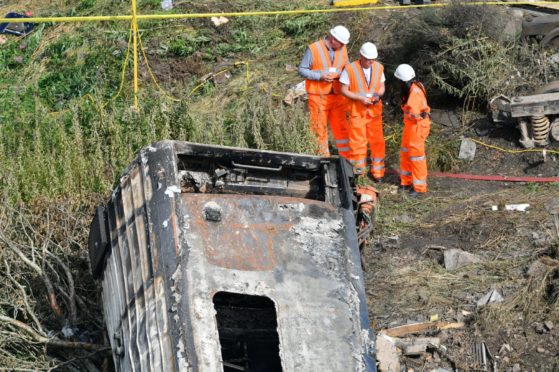An interim report into the Stonehaven rail tragedy has been published today by Network Rail.
The report, which was commissioned by UK Transport Secretary Grant Shapps in the aftermath of the disaster, has set out immediate and long-term action required to improve resilience on the route in extreme weather.
The line has been closed since the incident at Carmont on August 12 with investigators seeking to try to piece together the circumstances that led to the tragic event.
Driver Brett McCullough, conductor Donald Dinnie and passenger Christopher Stuchbury died after the train derailed in bad weather almost one month ago.
The initial findings of the report suggest that after a period of heavy rainfall the train struck a pile of washed-out rock and gravel before derailing.
The interim report assesses the current controls and management of thousands of miles of earthworks – the sloped ground beside railway tracks – and sets out how the industry plans to reduce the risk of landslips on the network in the future.
The report also highlights the need for an increased focus on deploying technology across the rail network to predict failures and the need for investing in better forecasting to enable local decisions for imminent weather events.
Key findings also suggest that industry rules for reporting and responding to adverse rainfall will be improved and strengthened, helping signallers better manage services during bad weather.
Other plans include discussions with meteorologists to understand how real-time information can be better used to inform train operations about unpredictable extreme weather.
Hundreds of sites across the country have been inspected over the last three weeks by engineers, specialist contractors and supplemented by helicopter surveys to identify any significant issues requiring emergency intervention.
Transport Secretary Grant Shapps said: “The incident at Stonehaven was a tragedy, and my heart goes out to the friends and family of Driver Brett McCullough, conductor Donald Dinnie, and Christopher Stuchbury.
“We owe it to those who lost their lives, were injured, and were affected by this incident, to learn and act on every possible lesson to ensure this is never repeated.
“The independent investigation will enable us to understand exactly what went wrong, and make sure it does not happen again.
“We cannot delay learning the lessons.
“I welcome the work setting out the challenges in adapting our rail infrastructure to cope with increasing extreme weather events caused by climate change. The task is now to overcome those challenges.
“We will use the findings of this interim report to improve, shape and accelerate our work to build a more robust and resilient rail network, so that our railway continues to be one of the safest in the world.”
Mr Shapps is also writing to the Chief Constable Iain Livingstone recommending that PC Liam Mercer, one of the first people on scene following the derailment, is commended for his bravery.
Network Rail chief executive Andrew Haines said: “My thoughts remain with the families and friends of the three people who lost their lives, those who were injured and everybody affected by the tragedy at Stonehaven last month.
“We owe it to them, and all our passengers, to make sure we understand what happened and what more we should be doing to reduce the risk of it ever happening again.
“We are all aware that we are increasingly seeing more incidents of severe weather and as the report published today shows, earthworks and drainage infrastructure– some of which are more than 150 years old – prove to be a real challenge as the country experiences more heavy rainfall and flooding.
“Our railway is one of the safest in Europe and tragic accidents are incredibly rare, but something went wrong on 12 August near Stonehaven and it is a stark reminder that we must never take safety for granted.
“We are improving and accelerating our resilience work and will do everything we can to minimise the impact of weather on the safety and reliability of the railway as our climate continues to change.”
Network rail has also commissioned two independent task forces to establish how it can better manage its vast number of cuttings and embankments and its response to severe weather events.
Investigations by the Rail Accident Investigation Brand (RAIB), Office of Rail and Road, British Transport Police and Police Scotland are still underway.
A full report into the incident will be published by Network Rail in due course.










